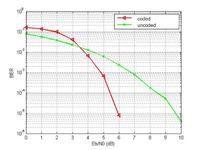byakuya
Junior Member level 3

- Joined
- Feb 3, 2011
- Messages
- 26
- Helped
- 2
- Reputation
- 4
- Reaction score
- 2
- Trophy points
- 1,283
- Activity points
- 1,442
hi, i've tried to simulate FEC and i got negative value when i calculate difference benween uncoded system and coded system ? (maybe i use FEC at unsuitable application)
can i expressed it as coding gain = -X dB?
can i expressed it as coding gain = -X dB?





